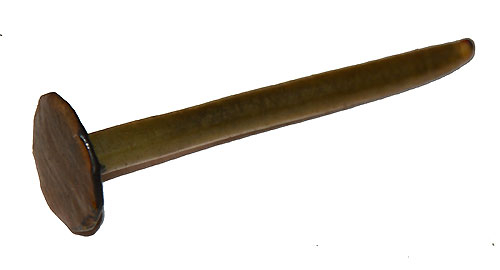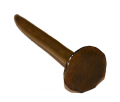site search
online catalog
CIVIL WAR “SPINNER” QUILL PRIMERS FOR NAVAL CANNONS

$175.00
Quantity Available: 5
Item Code: 2024-1521
Shipping: Determined by Method & Location of buyer
To Order:
Call 717-334-0347,
Fax 717-334-5016, or E-mail
These Naval cannon primers are constructed using fowl quills; less likely to corrode around salt water. These are percussion, not friction primers. In use, these were ignited by the blow from a hammer-lock affixed to the gun, not by pulling a serrated wire through it.
Unlike the more common “L-shaped” quill primers, these have a flat disc on top to hold the ignition material. This style has its origins in the French & Indian and Revolutionary Wars.
The explosive mixture employed was quite similar to others of the day - mealed musket powder, mercury fulminate and finely ground glass (preferably French leaded glass).
The quills measure approximately 2” long with a 0.65” diameter disc.
An ingenious primer for Naval guns. [jet][ph:L]
~~~~~~~~~~~~~~~~~~~~~~~~~~~~~~~~~~~
THIS ITEM, AS WITH ALL OTHER ITEMS AVAILABLE ON OUR WEB SITE,
MAY BE PURCHASED THROUGH OUR LAYAWAY PROGRAM.
CLICK HERE FOR OUR POLICIES AND TERMS.
THANK YOU!
Inquire About CIVIL WAR “SPINNER” QUILL PRIMERS FOR NAVAL CANNONS
For inquiries, please email us at [email protected]
Most Popular
Historical Firearms Stolen From The National Civil War Museum In Harrisburg, Pa »
Theft From Gravesite Of Gen. John Reynolds »
Selection Of Unframed Prints By Don Troiani »
Fine Condition Brass Infantry Bugle Insignia »
British Imported, Confederate Used Bayonet »
Scarce New Model 1865 Sharps Still In Percussion Near Factory New »
featured item
LARGE FRAMED RELIC SHOWBOARD
This relic board is very like those assembled from Gettysburg relics by John Rosensteel and displayed on the porch of the Round Top Museum, but differs in displaying the relics on horizontal rather than raw vertical boards, in having a glass frame,… (1242-06). Learn More »
site search
Upcoming Events
May 16 - 18: N-SSA Spring Nationals, Fort Shenandoah, Winchester, VA Learn More »




